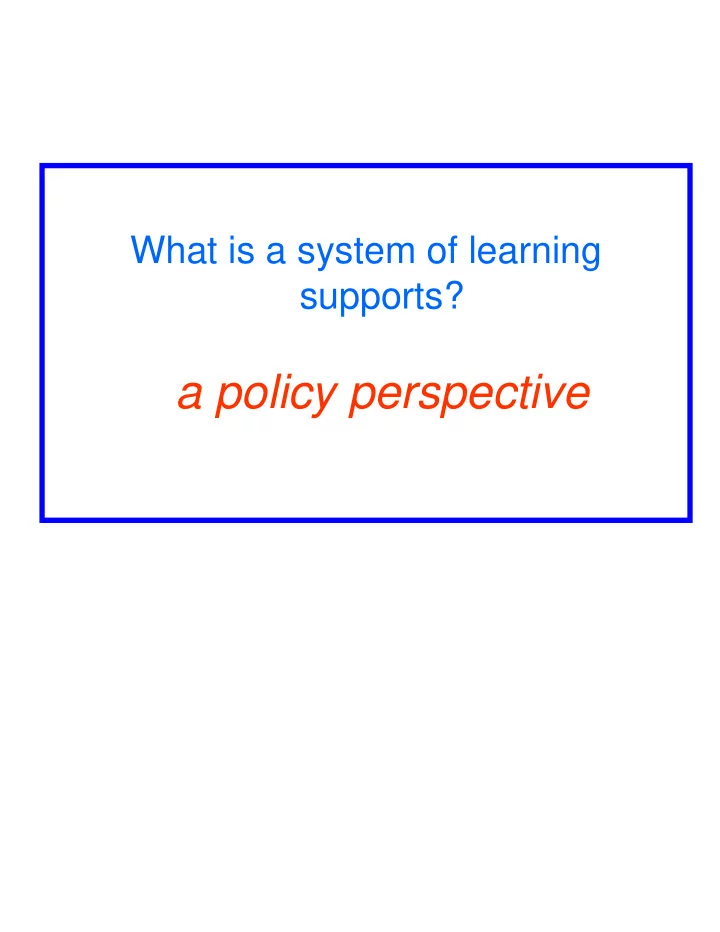

What is a system of learning supports? a policy perspective
Framing a Policy Perspective for Learning Supports • Defining a System of Learning Supports for Policy Purposes • Moving from a Two- to a Three- Component Policy Framework for School Improvement • The Learning Supports Component to Address Barriers Provides an Umbrella Concept for School Improvement Planning • Brief Overview of What is Involved in Building the System
Defining a System of Learning Support for Policy Purposes* Learning supports are the resources, strategies, and practices that provide physical, social, emotional, and intellectual supports intended to enable all pupils to have an equal opportunity for success at school. To accomplish this, a comprehensive, multifaceted, and cohesive learning support system should be integrated with instructional efforts and interventions provided in classrooms and schoolwide to address barriers to learning and teaching. *From: Proposed legislation in California to establish a Comprehensive Pupil Learning Support System
Moving from a Two- to a Three-component Framework for School Improvement Current State of Affairs Direct Facilitation of Student & Family Assistance Learning & Development Instructional/ Besides offering a small amount of Developmental school-owned student "support“ Component services, schools outreach to the community to add a few school- Management based/linked services. Component Governance and Resource Management Moving toward a Comprehensive System of Learning Supports Direct Facilitation of Addressing Barriers to Learning Learning & Development Instructional/ Learning Supports Developmental Component* Component Management Component Governance and Resource Management *The Learning Supports Component is designed to enable learning by addressing factors that interfere with learning and teaching. It is established in policy and practice as primary and essential and is developed into a comprehensive approach by weaving together school and community resources.
The Learning Supports Component to Address Barriers Provides an Umbrella Concept for School Improvement Planning Moving from a two- to a three-component policy framework for comprehensively addressing barriers to learning and teaching provides an umbrella concept for weaving together all student/learning supports. Such a policy framework allows for ending � Marginalization � fragmentation � wasteful redundancy � counterproductive competition for spare resources
Policy Umbrella for School Improvement Planning Related to Addressing Barriers to Learning Direct Facilitation of Learning Addressing Barriers to Learning/Teaching ( Enabling or Learning Supports Component – ( Instructional Component) an umbrella for ending marginalization by unifying the many fragmented efforts and evolving a comprehensive approach ) Examples of Initiatives, programs and services >positive behavioral supports >programs for safe and drug free schools >full service community schools & Family Resource Centers >Safe Schools/Healthy Students >School Based Health Center movement >Coordinated School Health Program >bi-lingual, cultural, and other diversity Programs >re-engaging disengaged students Governance and Resource Management >compensatory education programs >special education programs ( Management Component) >mandates stemming from the No Child Left Behind Act >And many more activities by student support staff
########################## Discussing Ways to Enhance Policy (1) How might a move to a 3 component approach to school improvement be incorporated into a school improvement plan? (2)Given the problems discussed, how might agencies rethink their approach to working with schools? ##########################
Brief Overview About Building a System of Learning Supports: Schools and Communities Working Together to Address Barriers to Learning & Improve Schools Schools and communities increasingly are being called on to meet the needs of all youngsters – including those experiencing behavior, learning, and emotional problems. The challenge for us all is to collaborate and maximize resources to strengthen young people, their families, and neighborhoods. Currently, the situation is one where there is a considerable amount of promising activity, but it is implemented in fragmented and often highly competitive ways. Of even greater import is the fact that most of this activity is marginalized in policy and practice, especially at school sites.
The need is to enhance policy and practice based on a unifying framework that is comprehensive, multifaceted, and integrated. For schools and communities, this means developing, over time, a full continuum of systemic interventions (not just integrated, school-linked services) that encompass � systems for promoting healthy development and preventing problems � systems for responding to problems as soon after onset as is feasible � systems for providing intensive care
At schools, and for school complexes and their neighborhoods, the need is to develop, over time, clusters of programmatic activity that address barriers to learning and enhance healthy development at all levels of the continuum. Based on analyses of school and community activity, such activity can be grouped into six basic content arenas designed to enable every school to: � enhance classroom-based efforts to enable learning � provide support for transitions � provide prescribed student and family assistance � increase home involvement in schooling � respond to and prevent crises � outreach to increase community involvement & support
Building all this requires fully integrating the above learning support frameworks into policy and practice for school improvement. It also requires rethinking infrastructure at all levels. Financing all this requires (a) weaving together school-owned resources and (b) enhancing programs by integrating school and community resources (including increasing access to community programs and services by integrating as many as feasible to fill gaps in programs and services). The end product will be a fundamental transformation of how the community and its schools address barriers to learning and enhance healthy development, and this should result in better achievement for all, a closing of the achievement gap, and schools being viewed as key hubs in their neighborhood.
Recommend
More recommend